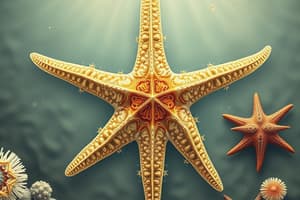Podcast
Questions and Answers
What is the function of the water vascular system in starfish?
What is the function of the water vascular system in starfish?
- Locomotion and feeding (correct)
- Gas exchange
- Reproduction
- Circulation of nutrients
What reproductive organs are primarily found in pheretima?
What reproductive organs are primarily found in pheretima?
- Ovaries and seminal vesicles
- Mature eggs and sperm ducts
- Testes and ovaries (correct)
- Ova and oviducts
What is one key function of the plasma membrane?
What is one key function of the plasma membrane?
- Protein synthesis
- Energy production
- Selective permeability (correct)
- Cell division
What is a primary characteristic of parthenogenesis?
What is a primary characteristic of parthenogenesis?
What is the significance of crossing over during meiosis?
What is the significance of crossing over during meiosis?
What is the main feature of a planula larva?
What is the main feature of a planula larva?
What is a primary characteristic of the liver fluke?
What is a primary characteristic of the liver fluke?
What role does the madreporite play in echinoderms?
What role does the madreporite play in echinoderms?
What is a significant consequence of torsion in gastropoda?
What is a significant consequence of torsion in gastropoda?
Which examination center was indicated for the B.Sc. annual examination?
Which examination center was indicated for the B.Sc. annual examination?
Flashcards are hidden until you start studying
Study Notes
Water Vascular System of Starfish
- Unique hydraulic system in echinoderms, specifically starfish, used for locomotion, feeding, and respiration.
- Composed of a network of fluid-filled canals that operate through water pressure.
- Key structures include the madreporite (water entry), stone canal, ring canal, radial canals, and tube feet.
- Tube feet function through hydraulic pressure, allowing for attachment to surfaces and movement.
- Essential for feeding mechanisms, as tube feet assist in prying open prey like bivalves.
Reproductive Organs of Pheretima
- Pheretima, commonly known as earthworms, possess both male and female reproductive organs (hermaphroditic).
- Male organs include testes and seminal vesicles, while female organs consist of ovaries and spermathecae.
- Fertilization occurs via copulation, after which a clitelum secretes a cocoon for egg deposition.
- Allows for genetic diversity through exchange of sperm between individuals.
Ultra-Structure and Functions of Plasma Membrane
- Composed of a phospholipid bilayer with embedded proteins, cholesterol, and carbohydrates.
- Functions as a selective barrier regulating the entry and exit of substances.
- Integral proteins serve as channels or receptors essential for cell communication and transport.
- Structure enables fluidity, crucial for cell signaling and interaction with the environment.
Parthenogenesis
- A type of asexual reproduction where an egg develops into an organism without fertilization.
- Common in some insects, reptiles, and plants, allowing for rapid population increase.
- Advantages include reproduction in the absence of mates and the ability to colonize new environments quickly.
- Genetic diversity might be limited compared to sexual reproduction.
Crossing Over and Its Utility
- A key process during meiosis where homologous chromosomes exchange segments of genetic material.
- Increases genetic diversity by creating new combinations of alleles in gametes.
- Essential for evolution, as it enhances adaptability and survival of species in changing environments.
Variation
- Variation refers to the differences among individuals within a species.
- Can be genetic (stemming from mutations and recombination) or environmental (influenced by habitat and conditions).
- Promotes adaptability and survival by providing a range of traits for natural selection.
Bipinnaria Larva
- A developmental stage in the life cycle of starfish, emerging from the fertilized egg.
- Characterized by a bilateral symmetry and arms that elongate into a swimming form.
- Important for dispersal in marine habitats, allowing for colonization of new areas.
Polymorphism
- The occurrence of different forms or morphs within a species.
- Common in insects and animals, such as variations in coloration, size, and behavior.
- Enhances survival by enabling species to adapt to diverse environments.
Book Lung
- A respiratory structure found in some arachnids, such as spiders.
- Composed of stacked layers (like pages of a book) that increase surface area for gas exchange.
- Allows efficient oxygen absorption and carbon dioxide release in terrestrial environments, enhancing survival.
Studying That Suits You
Use AI to generate personalized quizzes and flashcards to suit your learning preferences.




